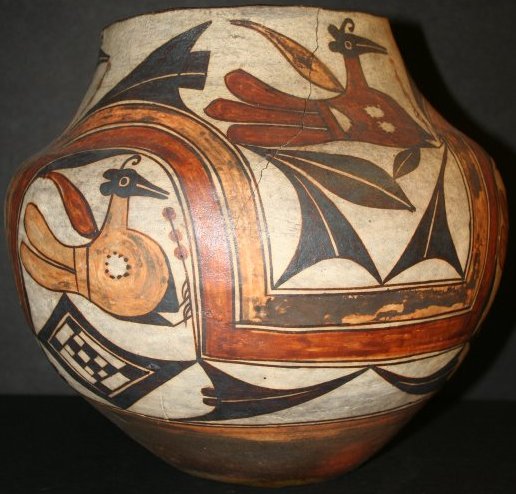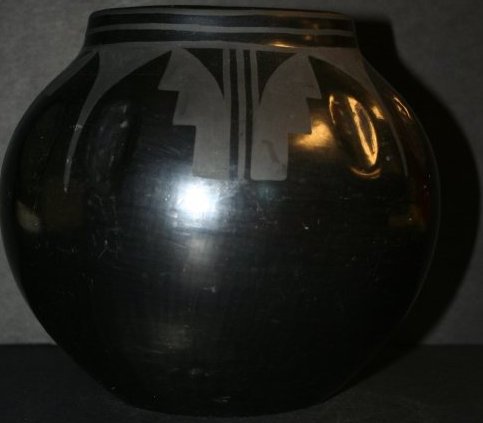Developments in transportation during the late nineteenth and early twentieth centuries increased white tourism, surveying, and settlement in the western United States. Photographs by white artists incorporated fire and water as potent subject matter to convey their experiences of this region. Moreover, they reveal that white settlers could transform fire and water into commodifiable resources themselves. However, sometimes fire and water are integral to the artistic process of creating. The ceramic vessels created by Puebloan artists in this section are examples of human intervention on land that worked with fire and water. The polychrome Olla was created according to pottery traditions of the Acoma or Laguna Pueblos, while Maria Martinez integrated earlier Pueblo aesthetics in creating her modern black-on-black ceramics. With the establishment of the Atchison, Topeka and Santa Fe Railway, greater numbers of tourists and curio traders were drawn to this region, with a particular interest in collecting “Indian crafts.” Thus, some of the ceramics created by Acoma and Laguna potters were a source of personal income for several Indigenous potters. Even Martinez’s signature on the bottom of her vessels is an indicator that she created these bowls for broader consumer markets. Nevertheless, the ceramics in this section define human intervention as an artistic process that works with the elements to carry on Indigenous artistic traditions.
This ceramic olla is an example of the rich pottery traditions of Acoma and Laguna peoples that feature land, water, and fire in creative processes. The clay that was used to make the vessels and their pigments were foraged from local deposits. White clay could create a cream-colored slip that coats the background of the design on this jar, while red and yellow clays were ground and mixed with water to form a consistency suitable for painting the rainbow arch that wraps around the jar. Black pigments were often made from grinding down an ore containing iron and manganese and mixing the powder with a syrupy binder made from boiled wild spinach.[1] Birds, in Pueblo belief, are connected to the rain and the sky. Their presence on this olla point to the rainfall that provided the damp conditions to create and mold clay.
This bowl is one of the many signature blackware ceramics created by the collaborative work of Maria Martinez (San Ildefonso Pueblo) and her spouse Julian (San Ildefonso Pueblo, 1879-1943). It is also a revival of older Puebloan pottery traditions and an example of the way Martinez worked with fire to create these ceramics. Both Maria and Julian were inspired by the pottery sherds found at the nearby excavation at Pajarito Plateau. After collecting the clay and forming the pot by hand, Maria burnished still-damp clay to create a lustrous sheen before Julian painted on designs, sometimes using an iron-bearing slip to achieve a matte finish in some areas. They then fired the ceramics using a reduction firing process where the amount of oxygen is limited to just burn the fuel. The resulting chemical reaction created the deep black coloration of her ceramics.
[1] Dwight P. Lanmon and Francis H. Harlow, The Pottery of Acoma Pueblo (Santa Fe: Museum of New Mexico Press, 2013).



